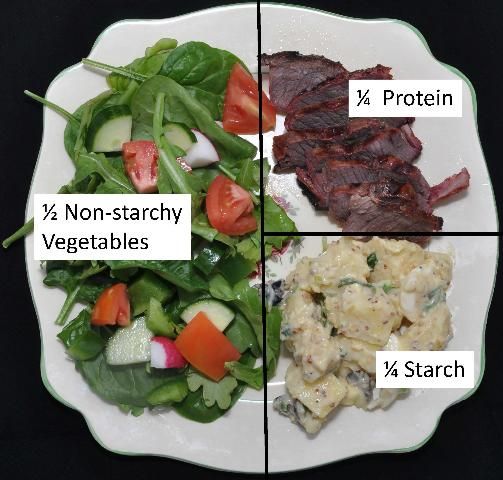Nutrition, physical activity, and medication are the three main components of a diabetes management plan. According to the American Diabetes Association, there is no one specific diabetes meal plan. If you have diabetes, taking an active role in your daily self-management is important. By working with a Registered Dietitian Nutritionist (RDN), preferably one who is a Certified Diabetes Educator (CDE), you can develop a personalized nutrition plan based on your treatment goals, medication, and personal preferences.
Main Goals of Nutrition Management
- Achieve individualized diabetes treatment goals related to A1C (a non-fasting blood test that measures your average blood glucose over the past two to three months), blood glucose, blood pressure, blood fats, and body weight.
- Prevent or delay the development or severity of diabetes complications.
- Promote healthful eating patterns consisting of nutrient-rich foods in appropriate amounts.
- Provide practical and individualized suggestions for daily meal planning.
- Improve health through optimal nutrition.
Creating Your Personalized Meal Plan
There are many healthful eating patterns suitable for managing diabetes. The best choice is an eating pattern that you can follow to meet your individualized treatment goals, personal preferences, and budget. Some examples of acceptable eating patterns include the Mediterranean-style eating approach, Dietary Approaches to Stop Hypertension (DASH), low-carbohydrate, and a plant-based diet.
Consider these factors when creating your meal plan:
- Blood fats
- Blood glucose
- Blood pressure
- Medication
- Body weight
- Budget and food availability
- Physical activity
- Culture
- Food preferences
- Lifestyle
- Medication
- Overall health status
Practice healthful eating behaviors
- Consume appropriate calories to achieve and maintain a healthy weight.
- Choose foods with lower amounts of total fat, saturated fat, sodium, and added sugars.
- Eat a variety of foods rich in nutrients and fiber.
- Enjoy sweets in moderation.
- Focus on non-starchy vegetables.
- Space meals and food sources of carbohydrates throughout the day.
The American Diabetes Association's Diabetes Plate Method
The Diabetes Plate Method is one meal-planning strategy that is very effective in managing carbohydrate intake and calories without having to weigh or measure food. The amount of carbohydrate you consume is based on your treatment plan and carbohydrate tolerance.
All you need is a 9-inch plate plus a small bowl and beverage glass to place foods from each of the five food groups: lean protein, starch, non-starchy vegetables, fruit, and milk (see Figure 1). Visually divide your plate into sections for non-starchy vegetables, starch, and lean protein foods. The small bowl is for fruit. The beverage glass is for milk or yogurt. The key is to select healthful foods from each of the five food groups to create your "healthy" plate.

Credit: Lincoln Zotarelli, UF/IFAS
The plate sections will control serving sizes to help manage calories and carbohydrate at each meal. You will also need to be mindful to choose foods that are lower in fat (especially saturated fat), sodium, and added sugars.
Because each person's dietary needs are different, it is important to consult with a Registered Dietitian, preferably a Certified Diabetes Educator (CDE), to determine your daily calorie needs and how many choices from each of the five food groups you require at each meal and snack. Make sure to consult with your healthcare provider before making any changes to your diabetes treatment plan.
Visit the American Diabetes Association's website at https://www.diabetesfoodhub.org/articles/what-is-the-diabetes-plate-method.html for more information on nutrition management for adults with diabetes.